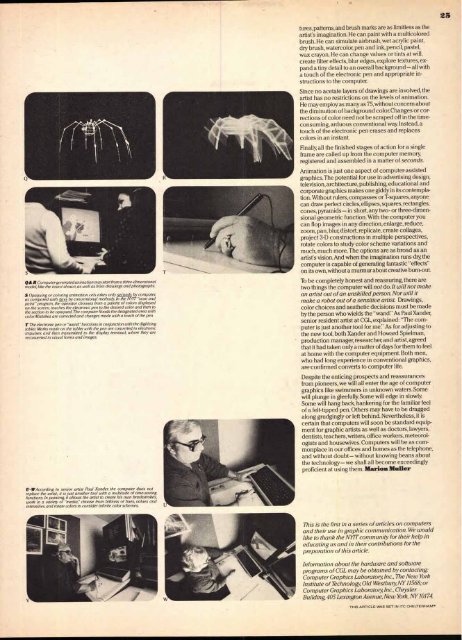Volume 9–2 (Low Res).pdf
Volume 9–2 (Low Res).pdf
Volume 9–2 (Low Res).pdf
You also want an ePaper? Increase the reach of your titles
YUMPU automatically turns print PDFs into web optimized ePapers that Google loves.
Q&R Computer-generated animation may start from a three-dimensional<br />
model, like the insect shown, as well as from drawings and photographs.<br />
S Opaquing or coloring animation cels takes only seconds by computer,<br />
as compared with days by conventional methods. In the NYIT "scan and<br />
paint" program, the operator chooses from a palette of colors displayed<br />
on the screen, touches the electronic pen to the desired color and then to<br />
the section to be opaqued. The computer floods the designated area with<br />
color Mistakes are corrected and changes made with a touch of the pen.<br />
T The electronic pen or "wand" functions in conjunction with the digitizing<br />
tablet. Marks made on the tablet with the pen are converted to electronic<br />
impulses and then transmitted to the display terminal, where they are<br />
reconverted to visual forms and images.<br />
U-W According to senior artist Paul Xander, the computer does not<br />
replace the artist; it is just another tool with a multitude of time-saving<br />
functions. In painting, it allows the artist to create his own brushstrokes,<br />
work in a variety of "media," choose from billions of hues, values and<br />
intensities, and rotate colors to consider infinite color schemes.<br />
tures, patterns, and brush marks are as limitless as the<br />
artist's imagination. He can paint with a multicolored<br />
brush. He can simulate airbrush, wet acrylic paint,<br />
dry brush, watercolor, pen and ink, pencil, pastel,<br />
wax crayon. He can change values or tints at will,<br />
create filter effects, blur edges, explore textures, expand<br />
a tiny detail to an overall background — all with<br />
a touch of the electronic pen and appropriate instructions<br />
to the computer.<br />
Since no acetate layers of drawings are involved, the<br />
artist has no restrictions on the levels of animation.<br />
He may employ as many as 75, without concern about<br />
the diminution of background color. Changes or corrections<br />
of color need not be scraped off in the timeconsuming,<br />
arduous conventional way. Instead, a<br />
touch of the electronic pen erases and replaces<br />
colors in an instant.<br />
Finally, all the finished stages of action for a single<br />
frame are called up from the computer memory,<br />
registered and assembled in a matter of seconds.<br />
Animation is just one aspect of computer-assisted<br />
graphics. The potential for use in advertising design,<br />
television, architecture, publishing, educational and<br />
corporate graphics makes one giddy in its contemplation.<br />
Without rulers, compasses or T-squares, anyone<br />
can draw perfect circles, ellipses, squares, rectangles,<br />
cones, pyramids— in short, any two- or three-dimensional<br />
geometric function. With the computer you<br />
can flop images in any direction, enlarge, reduce,<br />
zoom, pan, blur, distort, replicate, create collages,<br />
project 3-D constructions in multiple perspectives,<br />
rotate colors to study color scheme variations and<br />
much, much more. The options are as broad as an<br />
artist's vision. And when the imagination runs dry, the<br />
computer is capable of generating fantastic "effects"<br />
on its own,without a murmur about creative bum-out.<br />
To be completely honest and reassuring, there are<br />
two things the computer will not do./t will not make<br />
an artist out of an unskilled person. Nor will it<br />
make a robot out of a sensitive artist. Drawings,<br />
color choices and aesthetic decisions must be made<br />
by the person who wields the "wand:' As Paul Xander,<br />
senior resident artist at CGL, explained: "The computer<br />
is just another tool for me:' As for adjusting to<br />
the new tool, both Xander and Howard Spielman,<br />
production manager, researcher, and artist, agreed<br />
that it had taken only a matter of days for them to feel<br />
at home with the computer equipment. Both men,<br />
who had long experience in conventional graphics,<br />
are confirmed converts to computer life.<br />
Despite the enticing prospects and reassurances<br />
from pioneers, we will all enter the age of computer<br />
graphics like swimmers in unknown waters. Some<br />
will plunge in gleefully. Some will edge in slowly.<br />
Some will hang back, hankering for the familiar feel<br />
of a felt-tipped pen. Others may have to be dragged<br />
along grudgingly or left behind. Nevertheless, it is<br />
certain that computers will soon be standard equipment<br />
for graphic artists as well as doctors, lawyers,<br />
dentists, teachers, writers, office workers, meteorologists<br />
and housewives. Computers will be as commonplace<br />
in our offices and homes as the telephone,<br />
and without doubt— without knowing beans about<br />
the technology— we shall all become exceedingly<br />
proficient at using them. Marion Muller<br />
This is the first in a series of articles on computers<br />
and their use in graphic communication. We would<br />
like to thank the NYIT community for their help in<br />
educating us and in their contributions for the<br />
preparation of this article.<br />
Information about the hardware and software<br />
programs of CGL may be obtained by contacting:<br />
Computer Graphics Laboratory Inc., The New York<br />
Institute of Technology, Old Westbury NY 11568; or<br />
Computer Graphics Laboratory Inc., Chrysler<br />
Building, 405 Lexington Avenue, New York, NY 10174.<br />
THIS ARTICLE WAS SET IN ITC CHELTENHAM'
















